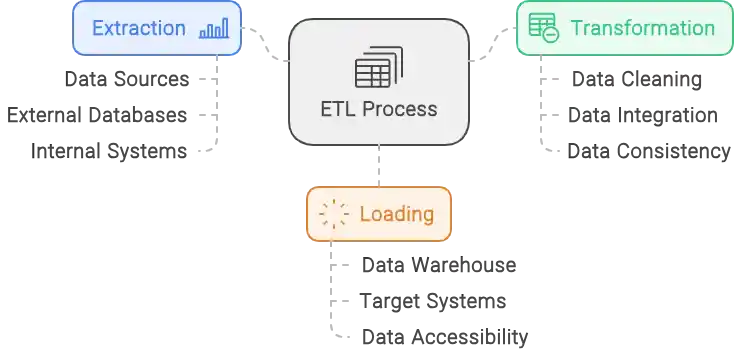Table of Contents
Introduction
In the realm of data management, two colossal forces have been shaping the way organizations harness their information: ETL and ELT. These acronyms, while seemingly simple, represent distinct approaches to extracting, transforming, and loading data. The choice between ETL and ELT can significantly impact an organization’s data strategy, performance, and overall efficiency. In this comprehensive exploration, we will delve into the intricacies of both ETL and ELT, uncovering their strengths, weaknesses, and ideal use cases.
Defining the Contenders: ETL and ELT
ETL, which stands for Extract, Transform, and Load, is the traditional method for moving data from disparate sources into a centralized data warehouse. This process involves extracting data from its original location, transforming it to meet the desired format, and then loading it into the target system.
ELT, on the other hand, flips the script by prioritizing speed and flexibility. It stands for Extract, Load, and Transform, meaning data is extracted from sources and loaded directly into a data warehouse or data lake without undergoing immediate transformation. The transformation process occurs within the data warehouse or data lake, leveraging its powerful computing resources.
The Importance of Understanding ETL vs ELT
Understanding the nuances between ETL and ELT is paramount for organizations seeking to optimize their data pipelines. By comprehending the strengths and weaknesses of each approach, businesses can make informed decisions about which method aligns best with their specific needs. Whether you’re dealing with small, structured datasets or massive, complex data volumes, the choice between ETL and ELT will significantly influence your data management journey.
ETL
ETL has been a cornerstone of data integration for decades. It offers a structured and controlled approach to data transformation, ensuring data quality and consistency. Let’s analyze the main parts of the ETL process:

Stages of the ETL Process
- Extract: The ETL process begins by extracting data from various sources, such as databases, flat files, and APIs. This involves connecting to the data sources and retrieving the necessary information.
- Transform: Once the data is extracted, it undergoes a transformation process to clean, standardize, and enrich it. This step involves handling missing values, correcting inconsistencies, and creating derived fields.
- Load: The final stage involves loading the transformed data into the target data warehouse or data mart. This process often includes indexing and partitioning data for optimal performance.
Use Cases and Industries
ETL is particularly well-suited for organizations with stringent data quality requirements and complex transformation logic. For instance, in the highly regulated financial industry, ETL is indispensable for ensuring compliance with data accuracy and consistency standards. ETL’s ability to meticulously clean, validate, and transform data before loading it into a data warehouse is crucial for maintaining the integrity of financial data. Additionally, industries like healthcare, where data accuracy is paramount for patient care and research, rely heavily on ETL to ensure reliable and trustworthy information.
Furthermore, ETL’s structured approach and data governance capabilities make it an ideal choice for organizations with complex data integration challenges. When dealing with multiple data sources, varying formats, and intricate transformation rules, ETL provides a robust framework for managing the entire data lifecycle. By centralizing data transformations and enforcing data quality standards, ETL helps organizations establish a solid foundation for data-driven decision-making.
Advantages of ETL
- Data Quality: ETL processes excel at improving data quality by cleaning, validating, and standardizing data before loading it into the target system.
- Data Governance: ETL provides a centralized platform for managing data transformations, making it easier to implement data governance policies and ensure data security.
ELT
ELT has emerged as a powerful alternative to ETL, especially in the era of big data. By deferring transformations until after data is loaded, ELT offers greater flexibility and scalability. Let’s explore the ELT process in detail:

Stages of the ELT Process
- Extract: Similar to ETL, the ELT process starts with extracting data from various sources. However, the extracted data is typically raw and unprocessed.
- Load: The extracted data is then loaded directly into a data warehouse or data lake without any immediate transformations. This allows for rapid ingestion of large data volumes.
- Transform: Once the data is loaded, transformations can be applied using the powerful computing capabilities of the data warehouse or data lake. This approach enables iterative exploration and refinement of data.
Use Cases and Industries
ELT is a compelling choice for organizations that prioritize speed, agility, and the ability to handle vast amounts of data. Its ability to quickly ingest data into a data warehouse or data lake empowers analysts and data scientists to explore and derive insights without being hindered by upfront transformations. This approach is particularly beneficial in industries characterized by rapid change and the need for real-time analytics, such as marketing, retail, e-commerce, and financial services.
For instance, in the fast-paced world of e-commerce, ELT enables businesses to swiftly capture customer interactions, product sales, and website traffic data. By loading this data into a data lake, organizations can uncover valuable patterns and trends through advanced analytics. This agility allows for rapid decision-making and the ability to adapt to changing market conditions.
Advantages of ELT
- Scalability: ELT can handle massive datasets efficiently by leveraging the processing power of the data warehouse or data lake.
- Flexibility: ELT allows for experimentation and exploration of data without the need for upfront transformations, making it adaptable to changing business requirements.
Key Differences Between ETL and ELT
While ETL and ELT share the common goal of moving data from source to target, their approaches diverge significantly. Let’s examine the key differences between these two methodologies:
Process Flow Comparison
- ETL: Extract -> Transform -> Load
- ELT: Extract -> Load -> Transform
Data Processing Environments
- ETL: Data is typically processed in a separate staging area before loading into the target system.
- ELT: Data is processed within the data warehouse or data lake.
Performance Considerations
- ETL: This can be slower due to the additional transformation step before loading.
- ELT: Often faster as data loading is prioritized, allowing for parallel processing and optimization within the data warehouse or data lake.
Complexity and Resource Requirements
- ETL: Generally requires more complex infrastructure and skilled personnel for data transformation.
- ELT: This can be simpler to implement, especially for cloud-based data warehouses and data lakes.
When to Use ETL vs ELT
Selecting the appropriate approach between ETL and ELT depends on various factors. Let’s explore when each method is the preferred choice:
Ideal Scenarios for ETL
- High data quality requirements: ETL excels at cleaning and standardizing data before loading.
- Complex data transformations: ETL provides a controlled environment for intricate data manipulation.
- Regulatory compliance: ETL can help ensure data integrity and security.
Ideal Scenarios for ELT
- Large data volumes: ELT can handle massive datasets efficiently.
- Rapid data ingestion: ELT prioritizes loading data quickly for immediate analysis.
- Agile data exploration: ELT allows for iterative data discovery and refinement.
Factors Influencing the Choice
- Data volume and velocity: For large, rapidly changing datasets, ELT might be more suitable.
- Data complexity and quality: If data is complex and requires extensive cleaning, ETL is often preferred.
- IT resources and expertise: The availability of skilled personnel can influence the choice between ETL and ELT.
- Organizational culture and risk tolerance: Some organizations may prefer the controlled approach of ETL, while others embrace the agility of ELT.
The Future of Data Integration
While ETL and ELT have been the dominant paradigms, the data landscape is constantly evolving. Emerging technologies and architectural patterns are introducing new possibilities for data integration. Cloud-based data warehouses, data lakes, and serverless computing are reshaping how organizations handle data.
As data volumes continue to explode, hybrid approaches that combine the strengths of ETL and ELT are gaining traction. These approaches involve using ETL for critical data transformations and ELT for bulk loading and initial exploration. Data virtualization and mesh architectures are also emerging as alternatives to traditional ETL and ELT pipelines.
Final Thoughts on ETL vs ELT
Choosing between ETL and ELT isn’t a decision that works for everyone. It requires a careful evaluation of an organization’s specific needs, data characteristics, and resources. By understanding the core principles and trade-offs of each approach, businesses can make informed decisions to optimize their data pipelines and unlock the full potential of their data assets.